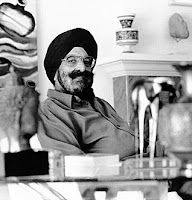 |
| Narinder Singh Kapany at work |
 |
| On a television show in 1960 |
Despite his significant contributions to the field his name was not included in the Nobel Prize for Fibre Optic Communications. His name remains absent from most textbooks in India and abroad. Kapany has been felicitated with the Pravasi Bhartiya Samman and The Excellence 2000 Award. He has keen interests in sculpting, philanthropy and art collection and has created 40 sculptures which were displayed at various art centres throughout the Unites States. He made significant contributions to Sikh studies and promoted Sikh culture in America.
 |
| Dr. Narinder Singh Kapany |
References
Other Reads:
Tech Help
How to use Instagram on Desktop
Comments
by mistake, while I was looking on Askjeeve for something
else, Anyways I am here now and would just like to say cheers for a incredible post annd a all round enjoyable blog (I also love the theme/design), I don't have
time to look over it all at the minute but I have bookmarked it and also
included your RSS feeds, so when I have time I will be back to read more, Please
do keep up the great work.
Also visit my web-site - acne exercise